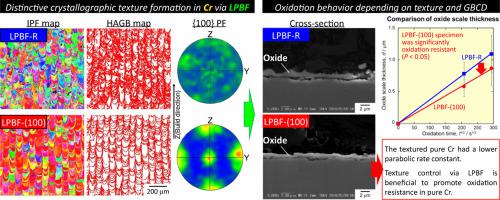Additive Manufacturing ( IF 10.3 ) Pub Date : 2020-10-01 , DOI: 10.1016/j.addma.2020.101624 Ozkan Gokcekaya , Naohiro Hayashi , Takuya Ishimoto , Kyosuke Ueda , Takayuki Narushima , Takayoshi Nakano

|
This is the first comprehensive study on the development of a cubic crystallographic texture in pure chromium (Cr) manufactured using laser powder bed fusion (LPBF) with different laser energy densities to alter its microstructure and high-temperature oxidation behavior. An increase in the laser energy density led to the formation of a strong crystallographic texture, which was preferentially oriented in the (100) plane, and there were microstructural improvements in the pure Cr. The grain size of the (100)-oriented Cr was larger than that of the randomly oriented Cr. In addition, the high-angle grain boundary and coincident site lattice (CSL) boundary characteristics were altered. The (100)-oriented Cr exhibited a decrease in the oxide thickness that was due to the decrease in the grain boundary density with a larger grain size and an increase in the CSL boundary ratio. In contrast, the Cr with a random texture showed higher oxidation kinetics and spallation of the oxide layer. The oxidation kinetics of the pure Cr manufactured using LPBF obeyed the parabolic rate law. However, the crystal orientation affected the oxidation of the Cr as the (100)-oriented pure Cr displayed a lower parabolic rate constant, indicating that the (100)-oriented Cr was oxidation-resistant. This is the first report to demonstrate the cubic crystallographic texture formation and the improvement of high-temperature oxidation resistance in Cr manufactured using LPBF.
中文翻译:

通过激光粉末床熔合控制纯铬的晶体学取向和提高的高温抗氧化性
这是对使用不同能量密度的激光粉末床熔合(LPBF)改变其微观结构和高温氧化行为的纯粉末(CrBF)制造的纯铬(Cr)的立方晶体织构发展的首次综合研究。激光能量密度的增加导致形成强烈的晶体学织构,该织构优先在(100)平面取向,并且纯Cr的微观结构得到改善。(100)取向的Cr的晶粒尺寸大于无规取向的Cr的晶粒尺寸。此外,改变了高角度晶界和重合点晶格(CSL)的边界特性。(100)取向的Cr表现出氧化物厚度的减少,这是由于具有较大晶粒尺寸的晶界密度的降低和CSL边界比的增加的缘故。相反,具有无规织构的Cr表现出较高的氧化动力学和氧化物层的散裂。使用LPBF生产的纯Cr的氧化动力学服从抛物线速率定律。但是,晶体取向影响Cr的氧化,因为(100)取向的纯Cr显示出较低的抛物线速率常数,表明(100)取向的Cr具有抗氧化性。这是第一份证明使用LPBF生产的铬中立方晶体织构的形成和高温抗氧化性改善的报告。具有随机织构的铬表现出较高的氧化动力学和氧化层剥落。使用LPBF生产的纯Cr的氧化动力学服从抛物线速率定律。但是,晶体取向影响Cr的氧化,因为(100)取向的纯Cr显示出较低的抛物线速率常数,表明(100)取向的Cr具有抗氧化性。这是第一份证明使用LPBF生产的铬中立方晶体织构的形成和高温抗氧化性改善的报告。具有随机织构的铬表现出较高的氧化动力学和氧化层剥落。使用LPBF生产的纯Cr的氧化动力学服从抛物线速率定律。但是,晶体取向影响Cr的氧化,因为(100)取向的纯Cr显示出较低的抛物线速率常数,表明(100)取向的Cr具有抗氧化性。这是第一份证明使用LPBF生产的铬中立方晶体织构的形成和高温抗氧化性改善的报告。表明(100)取向的Cr是抗氧化的。这是第一份证明使用LPBF生产的铬中立方晶体织构的形成和高温抗氧化性改善的报告。表明(100)取向的Cr是抗氧化的。这是第一份证明使用LPBF生产的铬中立方晶体织构的形成和高温抗氧化性改善的报告。











































 京公网安备 11010802027423号
京公网安备 11010802027423号